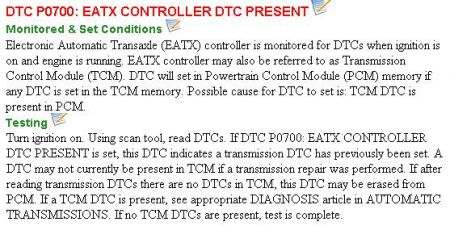Try this diagnostic.

DTC P0725: ENGINE SPEED SENSOR CIRCUIT
NOTE: Crankshaft position (CKP) sensor signal may also be know as EATX RPM signal.
NOTE: Ensure PRE-DIAGNOSTIC CHECK has been performed before proceeding with the following procedure.
Circuit Description
DTC P0725 will set when engine speed is less than 390 RPM or greater than 8000 RPM for more than 2 seconds with engine running.
Possible Cause
Open crankshaft position sensor signal circuit.
Crankshaft position sensor signal circuit shorted to ground.
Crankshaft position sensor signal circuit shorted to voltage.
Malfunctioning TCM.
Malfunctioning PCM.
Diagnostic Procedure
1. Using scan tool, read PCM DTCs. See appropriate SELF-DIAGNOSTICS article in ENGINE
PERFORMANCE. If any crankshaft position sensor DTCs are present, diagnose and repair fault
before proceeding. If no crankshaft position sensor DTCs are present, go to next step.
2. Using scan tool, check STARTS SINCE SET counter. If counter is not set to zero, go to step 8. If
counter is set to zero, go to next step.
3. Turn ignition off. Disconnect TCM and PCM harness connectors. Measure resistance of
crankshaft position sensor signal circuit between TCM and PCM harness connectors. See
WIRING DIAGRAMS. If resistance is less than 5 ohms, go to next step. If resistance is not less
than 5 ohms, repair open in crankshaft position sensor signal circuit.
4. Measure resistance between ground and terminal No. 6 (crankshaft position sensor signal circuit)
at TCM harness connector. If resistance is less than 5 ohms, repair crankshaft position sensor
signal circuit for short to ground. If resistance is not less than 5 ohms, go to next step.
5. Connect TCM harness connector. Ensure PCM harness connector is disconnected. Turn ignition
on. Measure voltage between ground and crankshaft position sensor signal terminal at appropriate
PCM harness connector. See WIRING DIAGRAMS. If voltage is 10 volts or less, go to next
step. If voltage is greater than 10 volts, repair crankshaft position sensor signal circuit for short to
voltage.
6. Measure voltage between PCM harness connector ground and crankshaft position sensor signal
terminals. Ensure ignition is on. If voltage is 4.5-5.5 volts, replace PCM. See appropriate
REMOVAL, OVERHAUL & INSTALLATION article in ENGINE PERFORMANCE. If voltage
is not 4.5-5.5 volts, go to next step.
7. If not problems have been found, replace TCM. See TRANSMISSION CONTROL MODULE
under REMOVAL & INSTALLATION. Perform SHIFT QUALITY QUICK-LEARN
PROCEDURE and PINION FACTOR PROCEDURE under PROGRAMMING.
8. Conditions needed to set DTC P0725 are currently not present. Perform wiggle test to diagnose
intermittent or poor connections. Repair as needed. If no problems are found, testing is complete.
Monday, July 6th, 2020 AT 1:56 PM
(Merged)





